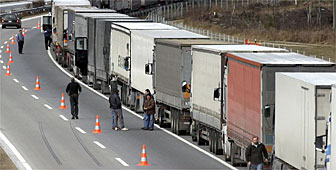Gotthard opening leaves truckers fearful about safety

Road hauliers have reacted with relief but concern at the reopening of the Gotthard road tunnel for trucks.
Transport organisations have welcomed the reopening, but say they are concerned about likely tailbacks of trucks on the approach roads and the possible accompanying hazards.
Trucks were once again allowed to use Gotthard as of Saturday, but drivers’ fears became a reality as they were forced to wait in ever-growing queues to enter the tunnel. Heavy snowfall complicated the Gotthard’s reopening and officials closed the route for a while.
Heavy goods vehicles are restricted to alternating, one-way traffic and have to keep a distance of at least 150 metres behind the vehicle in front of them.
The Swiss transport minister, Moritz Leuenberger, has set a ceiling of 3,700 trucks to use the tunnel daily.
Vital artery
“We’re relieved that the tunnel is open again. The Swiss authorities have moved very quickly to restore this vital, strategic artery and put it back into service,” International Road Transport Union spokesman, Guy Willis, told swissinfo.
“But I think the restrictions are a bit of a knee-jerk reaction by the authorities. To impose one-way traffic on trucks, but not on cars, gives the illusion of security without the reality. It will also create a lot of administrative problems and long delays for commercial vehicles,” he added.
The Swiss Road Haulers’ Association (Astag) in Bern also fears a build-up of trucks on the approach roads to the 16.9 kilometre long Gotthard tunnel, which was completed in 1980.
“We will have trucks parked on one driving lane and the hard shoulder, and only one lane will be left for private vehicles. That’s very dangerous,” Astag spokesman, Beat Keiser, told swissinfo.
“Drivers will have great problems if they have to wait around, not knowing when they can drive again.
“It’s now winter and not every truck is equipped with a heater that works when the engine is not running. There are very often no toilets around and no possibility to eat and drink,” he added.
Closure costs
The IRU in Geneva said tailbacks of trucks will only add to the costs that the two-month closure of the Gotthard has caused road transport companies.
“It’s clear costs have already gone up because of the closure of the Gotthard tunnel. The alternative routes are longer and time is money,” Willis said.
“The reopening will improve that situation but by imposing these additional security measures which really don’t contribute fundamentally to better safety, costs will be higher than they were before,” Willis added.
Astag has estimated that the alternative route over the San Bernardino Pass in eastern Switzerland added an extra SFr200 ($122.25) to the costs of transporting a truck, for example, from Lucerne in central Switzerland to Lugano.
Tighter controls
The Association told swissinfo that the accident in Gotthard had brought home the need for tighter controls.
“We have proposed that police should introduce more safety controls, particularly as far as the condition of the trucks are concerned and drivers’ working hours,” said Keiser.
The IRU confirmed that Switzerland lagged behind other countries in the number of controls carried out.
However, it feels that the real lesson from the blaze is the need for a second tube through the Gotthard to eliminate the potential for head-on collisions.
“It underlines a message that the IRU has been trying to put out for a long time: that major transit routes involving tunnels have to have two tubes, so that the traffic lanes are physically separated,” Willis said.
“This reduces the chance of an accident happening, it limits the amount of damage if an accident does happen, and it greatly facilitates the task of the emergency services… It also allows people to escape more easily and it ensures that if one of the tunnels is blocked, the other is still open,” he added.
by Robert Brookes

In compliance with the JTI standards
More: SWI swissinfo.ch certified by the Journalism Trust Initiative








You can find an overview of ongoing debates with our journalists here . Please join us!
If you want to start a conversation about a topic raised in this article or want to report factual errors, email us at english@swissinfo.ch.